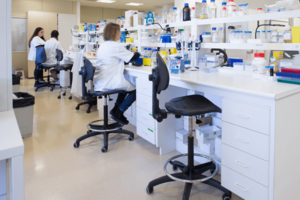Researchers at IRSJD develop a method to predict the efficacy of a potent nanomedicine in a severe childhood cancer
Researchers at IRSJD · SJD Barcelona Children’s Hospital have developed a method that predicts the anticancer efficacy of nab-paclitaxel, a well-known nanomedicine, in mouse models, for treatment of Ewing sarcoma, a severe cancer affecting the bones and soft tissue of children and adolescents.
Researchers have discovered that only Ewing sarcomas devoid of a protein named Bcl-2 in their cancer cells respond well to this medicine. The discovery will facilitate the selection of the patients for which this treatment would have real chances to succeed. The journal Biochemical Pharmacology has published the research.
Nab-paclitaxel is made of albumin particles bound to paclitaxel. It was developed by Celgene, a Bristol Myers Squibb Company. Nab-paclitaxel is approved for use as first-line treatment in adult patients with metastatic pancreatic adenocarcinoma, breast cancer, and non-small cell lung cancer. In children, this treatment is currently undergoing experimental phases in the frame of clinical trials.
Institut de Recerca Sant Joan de Déu researchers have discovered that nab-paclitaxel was efficacious only in Ewing sarcomas containing very low levels of the protein Bcl-2 in their cancer cells. Additionally, researchers studied other pediatric solid tumors, such as rhabdomyosarcoma and Wilms tumor. In these cancer types, however, they did not find a clear relationship between the presence or absence of Bcl-2 and the efficacy of nab-paclitaxel.
The director of the study, Dr Angel Carcaboso, head of Paediatric Cancer Treatment research group, explains that the research was conducted in 28 tumors obtained from pediatric patients and engrafted in mice, to identify a common ground in all of them that would identify the tumors responding better to the treatment.
"Most of these tumors, 15, were Ewing sarcomas, among which three completely disappeared after treatment. We did not find Bcl-2 in such three tumors". "During eight years -he adds- we engrafted tumor fragments from new patients in mice and performed studies until we obtained a number high enough to provide statistical power to identify a marker of response to treatment, that is, a biomarker".
The study suggests that one in every five patients with tumors resistant to first and second line treatments could obtain a benefit from nab-paclitaxel, after going through and easy and fast test to detect Bcl-2 in their cancer cells
A new treatment combination becomes possible
The study also proposes a method to increase the efficacy of nab-paclitaxel in patients whose tumors are Bcl-2-positive, because there are commercial treatments to annul the action of Bcl-2.
"We observed that the combined therapy with a Bcl-2 inhibitor reverted resistance to this nanomedicine in some of the tumors", points out Guillem Pascual-Pasto, first author of the study.
SJD PCCB was launched in 2022, with the ambition of becoming a world-leading new oncology center for treating children and teenagers. Research at SJD led to several phase 1 clinical trials in children with cancer, including novel advanced therapies. The scientific activity of SJD PCCB is part of one of the research programs of the Institut de Recerca Sant Joan de Déu (IRSJD), recognized by the Government of Catalonia as a research center of excellence.

The discovery will allow for a better selection of the patients with the highest chance to respond to this treatment.
